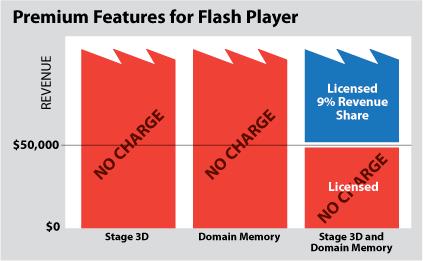Two important changes took place in the world of internet apps recently. The first, was the wide-scale support of accelerated HTML5 Canvas and WebGL elements, the second, Adobe's announcement that it would no longer be supporting Mobile and Linux platforms.
With these important changes taken into account, there's less reason than ever before for developers to begin investing in Adobe's Flash Player.
To clarify this writer's point, the greatest advantage of Flash for mobiles, was that it worked on browsers that didn't support other plugins, enabling a media-rich experience, even on a portable device; an advantage which will now dissipate as mobile operating systems move forwards, losing support for Flash Player and spurring on development of the HTML5 standard.
Likewise, the latest editions of Flash focus on 3D acceleration, however, several game engines exist, along with their own web plugins and mobile executables, that, with thanks to Linux and through apps, mobile support, will inevitably reach more platforms and a wider consumer base. One advantage of Flash is that many browsers come pre-bundled with the plugin, however, installing a third party plugin these days is hardly a task worth mentioning and with WebGL and HTML5 Canvas capabilities pushing forwards, the world of plugin-free web engines isn't too far away.

This leaves us with the primary advantage behind Flash and 3D acceleration, which is that, up until now, the plugin has remained free, at least with thanks to third-party development tools. However, Adobe has announced plans to begin charging users that utilise both domain memory and hardware acceleration. Should a firm or individual begin to bring in a net revenue of £31,000 or greater, Adobe will begin to charge a nine per cent royalty.
We wonder, as well, how this royalty charge may affect users of game engines that offer web support through Flash, where, both domain memory and hardware acceleration will likely be in use; would a user have to pay royalties to both the engine provider and Adobe? Likewise, bearing in mind that revenue does not represent profit, with the high costs of advertising and hosting, the nine per cent toll could have quite the impact on some firms.
This writer honestly doesn't quite understand just what Adobe is thinking. If any of our readers care to set him straight, they are more than welcome.
A good example of an affordable, multi-platform engine as a flash alternative (also supports Flash!):
Some examples of the progress of HTML5 Canvas:
http://spielzeugz.de/html5/liquid-particles.html













